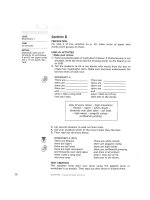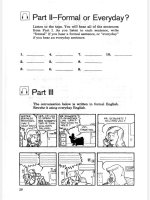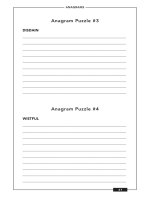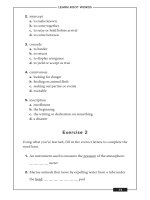SAT practise test 20000 part 5 ppsx
Bạn đang xem bản rút gọn của tài liệu. Xem và tải ngay bản đầy đủ của tài liệu tại đây (82.57 KB, 8 trang )
13. (y 1 2)
2
5 (y 2 4)
2
is true when y equals
(A) 1 only
(B) 1 and 21
(C) 2 and 22
(D) 1 and 2
(E) 2 and 4
14. Z is the set of numbers 1 through 50
inclusive. How many members of Z are
evenly divisible by 2 and 3?
(A)6
(B)8
(C)14
(D)16
(E)25
15.
Which of the following figures is similar
to the shape shown above?
(A)
(B)
(C)
(D)
(E)
33Copyright © 2005 Thomson Peterson’s, a part of The Thomson Corporaton
SAT is a registered trademark of the College Entrance Examination Board, which
was not involved in the production of and does not endorse this product.
16.
What is the area of the above figure?
(A)1
(B)
=
2
(C)2
(D)
1
=
2
(E)4
17. The sum of eight positive even integers is
50. If no integer can appear more than
twice in the set, what is the greatest
possible value of one of the integers.
(A)8
(B)18
(C)22
(D)24
(E)32
18.
ABC is an equilateral triangle and DEFG
is a square. If
AB 5 DE, how many
different ways can ABC be placed in
DEFG such that two vertices of the
triangle coincide with two corners of
the square?
(A)4
(B)6
(C)8
(D)10
(E)12
19. G, S, and T are three points that lie on a
plane. If the distance between G and S is
9, and the distance between S and T is 5,
which of the following are possible
distances between G and T?
I. 3
II. 5
III. 14
(A) I only
(B) II only
(C) I and II only
(D) II and III only
(E) I, II, and III
34 Copyright © 2005 Thomson Peterson’s, a part of The Thomson Corporaton
SAT is a registered trademark of the College Entrance Examination Board, which
was not involved in the production of and does not endorse this product.
20.
If AB 5 BC 5 AC 5 6, and D is the
halfway between A and C, then
BD 5
(A)
2
=
3
(B)3
(C)
3
=
3
(D)
4
=
2
(E)
4
=
3
21.
The figure above is the diagram of an
industrial fan blade. If the fan’s maximum
blade speed is 100 revolutions per 10
seconds, what is the greatest distance (in
feet) that any point on the blade could
travel in 30 seconds?
(A)
100
=
2p
(B)
200
=
3p
(C)
600
=
2p
(D)
600
=
3p
(E)
1200
=
2p
STOP
Do not proceed to the next section until time is up.
35Copyright © 2005 Thomson Peterson’s, a part of The Thomson Corporaton
SAT is a registered trademark of the College Entrance Examination Board, which
was not involved in the production of and does not endorse this product.
Section 6
16 Questions j Time—20 Minutes
Directions: Each passage below is followed by a set of questions. Read each passage, then
answer the accompanying questions, basing your answers on what is stated or implied in the
passage and any introductory material provided. Mark the letter of your choice on the answer
sheet that best corresponds to the correct answer.
Line Frederic Remington (1861–1909) has
long been celebrated as one of the most
gifted interpreters of the American West.
Initially, his western images appeared as
illustrations in popular journals. As he
matured, however, Remington turned his
attention away from illustration,
concentrating instead on painting and
sculpture. About 1900 he began a series
of paintings that took as their subject the
color of night. Before his premature
death in 1909 at age 48, Remington
completed more than seventy paintings in
which he explored the technical and
aesthetic difficulties of painting darkness.
1. The passage suggests Remington’s major
artistic accomplishments were
(A) magazine illustrations.
(B) sculptures.
(C) paintings of nocturnal cityscapes.
(D) paintings of nocturnal landscapes.
(E) color studies.
Line The question of what counts as literature
has been strongly debated over the last
few decades both in and out of academia.
Some argue that only the test of time
ultimately vindicates a fictional work’s
claim to the status of literature. Their
argument runs like this: if people still
read, still reference, still care about a
work of fiction decades or even centuries
after its original publication, then that
work clearly rises to the auspicious status
of literature. Critics of this view, though,
point out that this method of determining
what is and is not literature by definition
excludes contemporary works from
consideration. We do not know, they
rightfully contend, if a novel published in
the last few years will be read in a
hundred years or not. And so they ask,
does this mean we cannot meaningfully
discuss whether the work is important, or
influential, or of great merit?
(5)
(10)
(15)
(5)
(10)
(15)
(20)
36 Copyright © 2005 Thomson Peterson’s, a part of The Thomson Corporaton
SAT is a registered trademark of the College Entrance Examination Board, which
was not involved in the production of and does not endorse this product.
2. The author uses the word “vindicates” to
emphasize that
(A) all works of fiction claim to be
literature.
(B) all works of fiction are, in some
sense, literature.
(C) literature is a much more prestigious
category than fiction.
(D) the debate regarding what is litera-
ture is excessively erudite.
(E) for a work to establish itself as
literature is an incredible feat.
3. The argument, given in the passage,
against the “test of time” approach is that
(A) it excludes by definition all writing
that is not fictional.
(B) it does not take trends in critical
interest into account.
(C) it excludes contemporary fiction
from the discussion.
(D) it allows contemporary works to be
considered alongside the great works
of centuries past.
(E) it gives too much weight to popular
opinion.
Line Since the sixteenth century, astronomers
have recognized Mars for what it is—a
relatively nearby planet not so unlike our
own. The fourth planet from the sun and
Earth’s closest neighbor, Mars has been
the subject of modern scientists’ careful
scrutiny with powerful telescopes, deep
space probes, and orbiting spacecraft. In
1976, Earth-bound scientists were
brought significantly closer to their
subject of investigation when two Viking
probes touched down on that red soil.
The possibility of life on Mars, clues to
the evolution of the solar system,
fascination with the chemistry, geology,
and meteorology of another planet—
these were considerations that led the
National Aeronautics and Space Admin-
istration to Mars. Project Viking’s goal,
after making a soft landing on Mars, was
to execute a set of scientific investigations
that would not only provide data on the
physical nature of the planet but also
make a first attempt at determining if
detectable life forms were present.
4. Which of the following does the para-
graph most emphasize as the motivation
for the Viking trip to Mars?
(A) Fascination with chemistry on
another planet.
(B) Four-century-old interest inthe planet.
(C) The advancement of space explora-
tion.
(D) Possibility of a space station on Mars.
(E) Possibility of life on Mars.
Questions 5–16 are based on the following two
passages.
The following two passages discuss the English
and Metric systems of measurement.
Passage 1
Line It is an oft-repeated tale that the English
measurement of the yard was standard-
ized when an English royal stepped into
disputes about the measurement’s length
and declared the distance from his
shoulder to the tip of his fingers as the
standard yard. Unlike many colorful
anecdotes from history, this one is true.
Early in the twelfth century, the English
king Henry I established the length of the
yard as the distance from the tip of his
nose to the tip of his outstretched thumb.
In our scientific age such stories seem
earthy at best and ridiculous at worst.
(5)
(10)
(15)
(20)
(25)
(5)
(10)
37Copyright © 2005 Thomson Peterson’s, a part of The Thomson Corporaton
SAT is a registered trademark of the College Entrance Examination Board, which
was not involved in the production of and does not endorse this product.
But not all ancient units of measure have
such arbitrary origins. The mile is a good
example of this. Though the mile is today
counted as part of the English system of
measurement, the unit dates back to
ancient Rome. The English word mile
derives from the Latin term mille, which
means one thousand. For the Romans,
the mille was one thousand paces. A pace
was two steps, or five feet roughly. This
meant the mille was 5,000 feet. In
medieval Europe, however, the 220-yard
furlong became the dominant measure-
ment used. To reconcile the two measure-
ments, the mile was lengthened to be
eight furlongs. This made the mile 5,280
feet. A sixteenth-century act of Parlia-
ment fixed this measurement for the mile.
It is true that the English system of
measurement, the system that includes
the mile, the yard, the foot, and the inch,
has a certain quirkiness to it because it
has evolved through human history. This
quirkiness might irritate scientists, but it
is part and parcel of the tradition that
has been bequeathed, in its accumulated
form, to the English-speaking world.
Passage 2
The metric system was conceived by
twelve French scientists during the
French Revolution. Like many innova-
tions during the French Revolution, the
metric system was formulated as a
scientific system that would replace
traditional ways of ordering society. The
revolutionaries did not see it as a
coincidence that length was meted in
measures based on the size of a medieval
king. Instead of these arbitrary standards,
the metric system’s basic unit of measure,
the meter, was based upon the circumfer-
ence of the Earth. For the meter to be a
manageable size, it was defined as one
one-forty-millionth of the Earth’s
circumference. They employed the word
meter to harken back to the ancient
Greek word metron, meaning measure.
The rest of the metric system is even
less arbitrary in origin. The other metric
units of length were generated by either
multiplying or dividing the meter by a
factor of ten. Thus a kilometer is 1000
meters, and a centimeter is one one-
hundredths of a meter. It is the great asset
of the metric system, at least for scien-
tists, that units for measuring weight and
energy are also derived from the basic
unit of the meter. For instance, weight is
measured in grams, which are determined
by the weight of one cubic centimeter
of water.
France made use of the metric system
compulsory in 1840. Other countries
rapidly followed suit. The adoption of
the metric system, also known as the
international system, or S.I., coincided
with great advances in science. By 1900,
over 35 countries had officially adopted
its use. In the United States, the system
has been dubbed “voluntary” and
“preferred,” but has never been made
compulsory.
The measure of the meter has been
refined three times since its conception in
1791. The latest was in 1983 when the
speed of light was employed to give the
greatest precision for the measurement to
date. The distance that light travels in a
vacuum in 1/299,792,458 of a second is
the internationally accepted definition of
a meter.
(15)
(20)
(25)
(30)
(35)
(40)
(45)
(50)
(55)
(60)
(65)
(70)
(75)
(80)
(85)
(90)
38 Copyright © 2005 Thomson Peterson’s, a part of The Thomson Corporaton
SAT is a registered trademark of the College Entrance Examination Board, which
was not involved in the production of and does not endorse this product.
5. What is the author of Passage 1’s attitude
towards the English system of measure-
ment?
(A) Emphatic praise
(B) Qualified acceptance
(C) Neutrality
(D) Strong criticism
(E) Antipathy
6. In Passage 1, the story of Henry I is
offered primarily to
(A) demonstrate that the reader’s
preconceptions about the English
system are wrong.
(B) illustrate the role of the English
monarchy in the development of the
English system.
(C) reveal how far back in time the
English system goes.
(D) provide a concrete example of how
the arbitrariness of the English
system developed.
(E) suggest the practicality of the English
system.
7. The word “earthy” in line 14 most closely
means
(A) unrefined.
(B) musky.
(C) impractical.
(D) old-fashioned.
(E) baffling.
8. By “reconcile the two measurements,”
(line 28–32) the author means
(A) determine which one was accurate.
(B) develop a new system of measure-
ment without the inaccuracies of
the old.
(C) settle the public’s disagreement over
which was better.
(D) find a metric equivalent.
(E) cease using two different systems.
9. The author refers to the English system’s
“accumulated form” line 40–41 primarily
to emphasize that the system
(A) ceased to change once officially
adopted.
(B) derives from a variety of sources.
(C) stretches back further than reliable
written history.
(D) continues to evolve.
(E) was adopted wholesale.
10. The authors of the two passages would be
most likely to agree that the metric system
(A) has a shorter but equally interesting
history as the English system.
(B) has a history that reaches back as far
as the English system’s.
(C) has a longer history than the history
of the English system.
(D) should not be thought of historically.
(E) has a history that is equally long but
less colorful than the English
system’s.
39Copyright © 2005 Thomson Peterson’s, a part of The Thomson Corporaton
SAT is a registered trademark of the College Entrance Examination Board, which
was not involved in the production of and does not endorse this product.
11. According to Passage 2, the invention of
the metric system was
(A) one of the greatest accomplishments
of the French Revolution.
(B) in contradiction to many of the other
goals of the French Revolution.
(C) a side-effect of the French Revolu-
tion’s new calendar system.
(D) one of many anti-traditionalist
undertakings of the French Revolu-
tion.
(E) left incomplete at the end of the
French Revolution.
12. In the sentence beginning “In the United
States. . .” (line 82) the writer suggests
that the United States
(A) has never seriously attempted to
implement the metric system.
(B) is likely to adopt the metric system
fairly soon.
(C) has created official policies regarding
use of the metric system.
(D) has attempted to require use of the
metric system, but has been unable
to enforce its policies.
(E) reflects a clear bias for the superior-
ity of the English system.
13. The word “refined” in line 87 most
closely means
(A) processed.
(B) renegotiated.
(C) made smaller.
(D) challenged.
(E) modified.
14. In Passage 2, the reason for the 1983 defini-
tion of the meter is probably that scientists
(A) have determined that the new meter
is a more manageable length.
(B) have more sophisticated data on the
circumference of the earth.
(C) needed a way to bring the meter’s
length closer to the yard’s.
(D) have developed more accurate ways
to calculate the original fraction.
(E) wanted to disassociate the meter
with the French Revolution.
15. In at least one of the passages all of the
following are mentioned EXCEPT
(A) the kings who ruled during the
standardization of measurements.
(B) the contemporary standing of the
measuring system discussed.
(C) terms from ancient languages.
(D) the refinement of measurement
standards in recent years.
(E) the cultural heritage of each measur-
ing system.
16. The author of Passage 2 conveys an
implicit belief that the
(A) metric system facilitates scientific
endeavors.
(B) United States has damaged its reputa-
tion in the international community by
refusing to adopt the metric system.
(C) metric system is best confined to
scientific use.
(D) French Revolution was a high point
in the history of science.
(E) metric system is a more fitting system
for a democratic society.
STOP
Do not proceed to the next section until time is up.
40 Copyright © 2005 Thomson Peterson’s, a part of The Thomson Corporaton
SAT is a registered trademark of the College Entrance Examination Board, which
was not involved in the production of and does not endorse this product.









